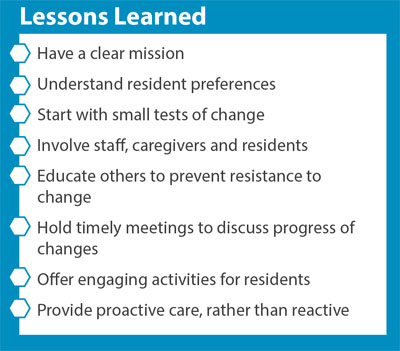Nursing Home Systematically Eliminates Restraint-Free Alarms
To tailor care plans to meet resident needs while removing RFAs, staff began by collecting information on resident activities, preferences and sleeping/toileting patterns. They also made it a priority to provide meaningful activities during the day, which would benefit the residents in uninterrupted REM sleep at night.
They started small, removing RFAs in one unit and one shift per week until working through all six units (208 beds total) and all three shifts. In addition, they stopped ordering RFAs on all new residents and discontinued RFAs on residents who didn’t experience a fall in 30 days. Nursing administration and unit managers made sure to be present when alarms on their hall were removed.
The Quality Assurance Coordinator (QAC) led the quality improvement project and involved all staff, including those from nursing, activities, housekeeping, therapy and maintenance.
The Alabama Quality Assurance Foundation (AQAF) offered quality improvement guidance and national nursing home best practices.
However, it wasn’t always easy. Some staff didn’t think they would be able to eliminate alarms and keep residents safe. Some family members resisted the change too.
Standridge and other leaders overcame the resistance through education. They distributed pamphlets and conducted an educational meeting for families to explain the alarm elimination information in detail.
They also educated staff that REM sleep deprivation leads to agitation, negative behaviors, poor mood and decreased appetite.
“This education was extremely helpful in reassuring families, residents and staff that our changes were going to be beneficial,” Standridge said.
To encourage REM sleep, they purchased new items to help decrease noise levels, such as new flooring and carts. They provided impromptu activities to keep the residents active and engaged during the day.
During daily quality assurance meetings held to discuss behaviors and falls from the previous day or night, staff noted increased sleep time for residents and reported on monitored falls.
One second-shift certified nursing assistant mentor reported she had more opportunity to interact with residents in meaningful activities. She developed a better understanding of her residents’ likes, dislikes and talents and noted that these same residents were ready to lie down at bedtime because they had been active and were tired.
“Before RFA elimination, our staff was providing reactionary caregiving; after the elimination, it changed to anticipatory,” Standridge said.
To ensure success in reduction of RFAs, Standridge advises other facilities to educate staff and start small. Those initial, small successes motivate front line staff and help caregivers buy in to the initiative and believe that the goals are attainable.
“Most importantly, get everyone involved,” she said, “Involve families; involve front line caregivers and staff. You need their input. This empowers them and it becomes their project.”

Preview: Nursing Home Eliminates Restraint-Free Alarms - AL Success Story
Download
628.66 KB | Last Updated: February 6, 2015

14.SS.AL.C2.09.001


